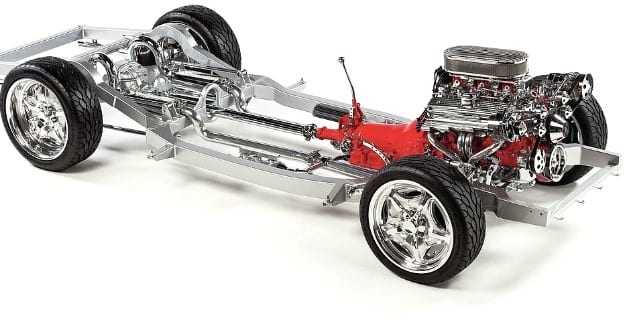
Что такое шасси, принцип работы и для чего оно нужно
Содержание
Шасси автомобиля
Новинка была построена на шасси предыдущей модели и получила множество технических и визуальных изменений. Так начинаются обзоры многих автомобилей очередного поколения. Что такое шасси, на котором выпускаются очередные модели? Разберемся с этим вопросом подробней.
Что такое шасси
Все механические транспортные средства состоят из трех основных узлов:
- силовая установка;
- кузов;
- шасси.
Шасси это не какая-то конкретная деталь в транспортном средстве. Иногда этим термином называют несущую конструкцию машины.
На самом деле шасси представляет собой набор механизмов, которые взаимодействуют с колесами и опорами автомобиля. Это узел, который объединяет в себе рулевое управление автомобилем, его трансмиссию, систему амортизации и ходовую часть. Все эти системы соединены на общем основании, и их работа синхронизируется так, чтобы весь автомобиль мог выполнять движение. Шасси также включает раму плюс силовые агрегаты — двигатель, трансмиссию и подвеску. На нем находится кузов, придающий автомобилю законченный вид.
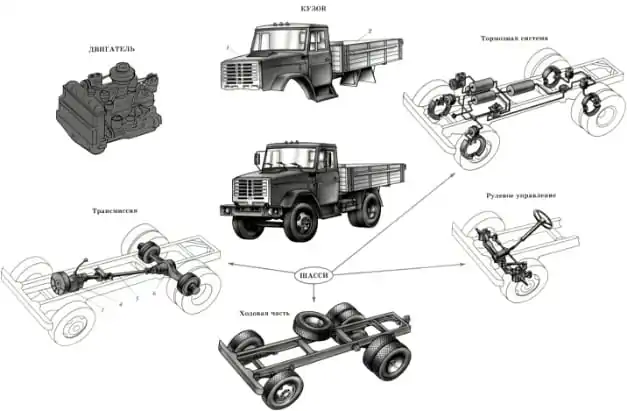
Под шасси автомобиля также подразумевается комплект деталей и узлов, от которых зависит движение и маневры транспортного средства. В технической документации машины он имеет маркировку, которая в этом случае соответствует номеру кузова (что такое номер шасси).
Основными составляющими шасси автомобиля являются две подвески — передняя и задняя, а также колеса. Подвески необходимы для смягчения или устранения колебаний при движении, благодаря которым автомобиль плавно преодолевает все неровности дороги.
Принцип работы и для чего оно нужно
Все необходимые для передвижения агрегаты монтируются на основание авто таким образом, чтобы вращательная энергия передавалась от двигателя на ведущие колеса. Вот как синхронизируется работа всех узлов:
- На подрамник установлен мотор. От него крутящий момент передается на передний или задний мост (в случае с полным или задним приводом). Благодаря этому колеса начинают вращаться, и машина движется вперед или назад.
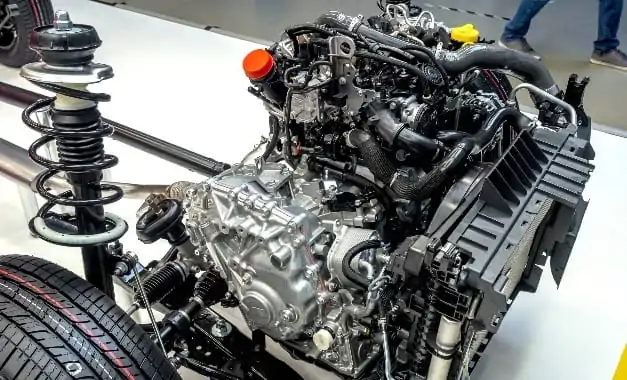
- Чтобы автомобиль мог менять свое направление, к нему подсоединяется рулевое управление. Ведущие колеса приводят авто в движение, а рулевые – задают ему направление. В этом узле много деталей, которые обеспечивают плавные маневры во время езды.
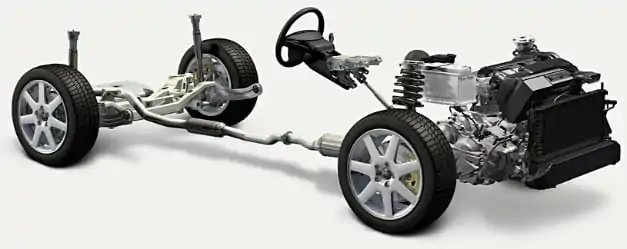
- Для изменения скорости автомобиля между силовым агрегатом и ведущими колесами устанавливается коробка передач. Она может быть механической или автоматической. В этом узле при помощи набора шестеренок крутящий момент увеличивается, что позволяет снять чрезмерную нагрузку с двигателя.
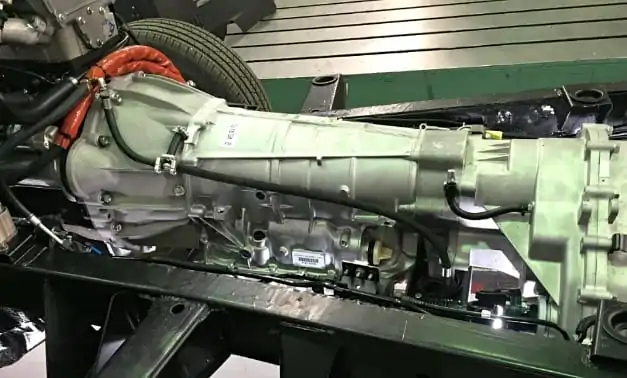
- Во время езды по дорогам разного качества возникают колебания. Из-за тряски и вибрации составные части трансмиссии и рулевого управления быстро выйдут из строя. Для компенсации такой нагрузки к подрамнику крепятся рычаги и амортизаторы.
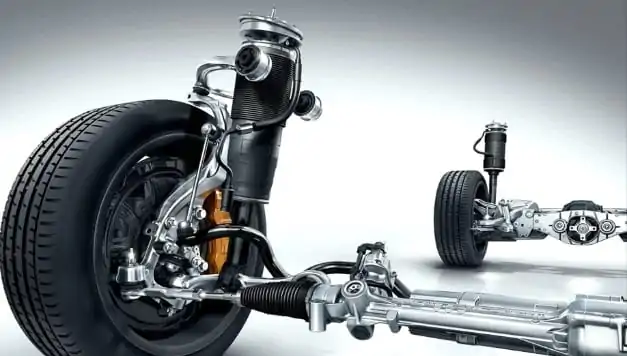
Как видно, шасси автомобиля позволяет приводить в движение всю конструкцию, менять ее направление и компенсировать нагрузки от вибраций, возникающие во время езды. Благодаря такой разработке вырабатываемая двигателем внутреннего сгорания энергия может быть использована для комфортной и безопасной транспортировки людей и больших грузов.
Устройство
Итак, под шасси подразумевается совокупность несущей части и некоторых ключевых компонентов, которые позволяют транспортному средству самостоятельно двигаться. Все типы конструкций делятся на две категории.
В первую категорию входят все автомобили с рамной конструкцией. В этом случае тележка авто состоит из рамы, к которой крепятся все агрегаты, механизмы и конструкции. Такие автомобили отличаются большим весом и имеют максимальную прочность. В основном такая конструкция у грузовых автомобилей и полноценных внедорожников.
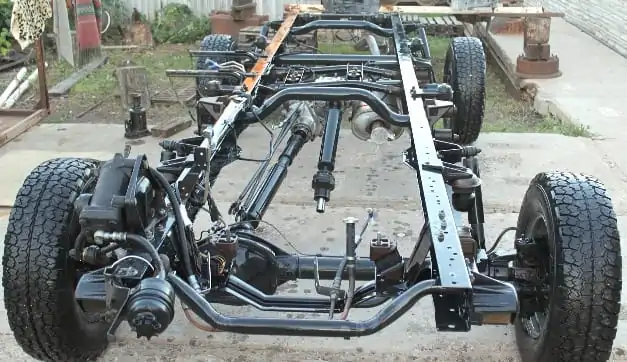
Во вторую категорию вошел тип шасси, который является сразу же частью кузова авто. Несущий кузов не такой прочный, как в случае полноценной рамы, зато он очень легкий, что имеет большое значение для легковых автомобилей. Только в такой модификации шасси есть возможность создавать максимально легкие суперкары.
Инженеры разных автопроизводителей разрабатывают свои конструкции несущих кузовов, которые отличаются не только особенностями конструкции, но и изготавливаются из разных материалов.
Вот короткое видео, в котором на примере моделей Mazda показывается, какое значение для современного автомобиля имеет использование легких материалов для шасси:
Элементы конструкции
Так как на шасси автомобиля все держится, эта часть транспортного средства должна всегда быть максимально прочной, а ее элементы должны выдерживать разные нагрузки, независимо от условий эксплуатации.
Современное шасси автомобиля состоит из следующих деталей и конструкций:
- Колес с покрышками;
- Трансмиссии;
- Подвески;
- Рулевого управления и тормозной системы.
Все эти элементы прочно фиксируются как на раме, так и на несущей части кузова.
Функциональность
Что касается легкового автомобиля, то шасси этого транспортного средства выполняют следующие функции:
- Позволяет задействовать тяговую силу для самостоятельного движения конструкции. Для этого в машине присутствует ходовая часть;
- Обеспечивает максимально плавное движение. За плавность движения отвечает подвеска и частично покрышки. Комфорт для водителя и пассажиров зависит от типа подвески и качества демпферных элементов;
- Позволяет управлять направлением движения конструкции. Эта функция возложена на рулевое управление.
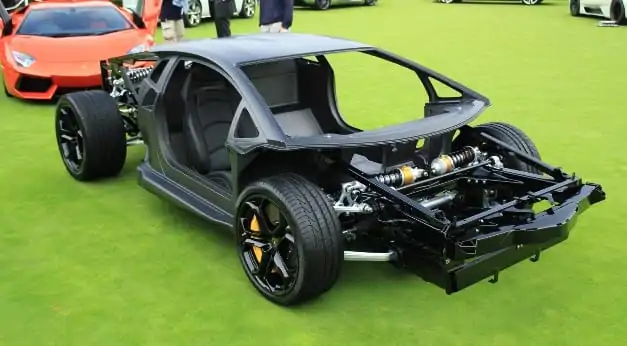
Каждое шасси проектируется с учетом разных дорожных условий так, чтобы преодолевая препятствия, машина выдерживала нагрузки на кручение кузова. Если эта нагрузка будет критической, несущая часть автомобиля деформируется, что повлияет на разные механизмы и элементы кузова (например, двери перестанут закрываться).
Подвеска
Это один из основных элементов шасси. От качества и особенностей конструкции этой части зависит устойчивость машины на поворотах. Также подвеска разрабатывается с учетом требований безопасности в соответствии с запросами современного автомобилиста, что касается комфорта.
Начиная с создания первого авто, и до сегодняшнего дня конструкция подвески постоянно совершенствуется, благодаря чему в автомире существует огромное разнообразие всевозможных конструкций подвесок. Основные отличия всех этих конструкций – в способе установки опоры машины (колес) на одной оси.
Зависимая подвеска
Это самый первый тип подвески авто. В данном случае колеса одной оси соединены между собой жестко. К достоинствам такой подвески следует отнести максимальный показатель сцепления колес с дорожным покрытием. Особенно это важно, когда машина входит в поворот на гладком покрытии. За счет жесткой фиксации каждое колесо сохраняет вертикальное положение.
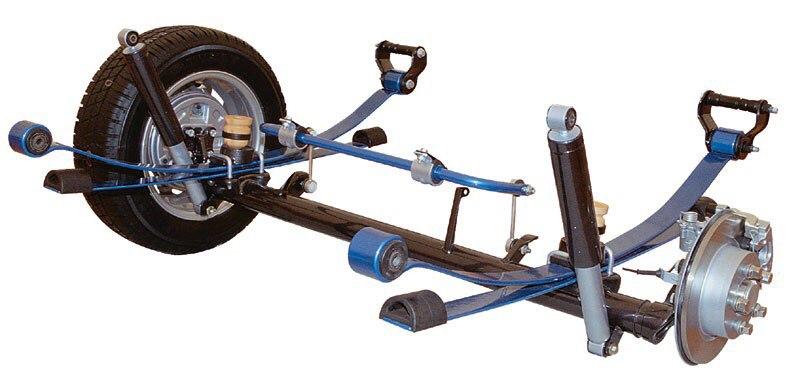
Если говорить о недостатках такого типа подвески, то во время езды по ухабам жестко связанные между собой колеса не обеспечивают плавность хода авто (одно колесо наезжает на бугор и изменяет наклон всей оси). В современных автомобилях от полностью зависимой подвески спереди уже отказались. Вместо нее устанавливается подвеска типа Макферсон.
Зависимая конструкция устанавливается исключительно на задней оси, независимо от того это ведущая или ведомая ось. Если это ведущая ось, то она представлена задним мостом, который обеспечивает жесткое соединение обоих колес. В ведомой оси используется поперечная балка или торсион.
Независимая подвеска
В этом случае колеса, установленные на оси, не соединены жестко между собой, поэтому их положение относительно горизонтали не влияет друг на друга. Чтобы обеспечивалось максимальное сцепление с дорогой, на такой подвеске устанавливается поперечный стабилизатор.

Такой тип подвески, несмотря на более сложную конструкцию, обеспечивает больший комфорт и имеет меньший вес по сравнению с зависимой подвеской. Благодаря этому современные автомобили становятся все более динамичными и максимально комфортными. К недостаткам относится необходимость постоянно регулировать развал-схождение.
Классификация
Как мы уже рассматривали, шасси в транспортном средстве необходимо для следующих целей:
- Обеспечивать движение транспортного средства за счет передачи крутящего момента от силового агрегата на трансмиссию и затем на колеса;
- Минимизировать нагрузки, которые поступают в процессе движения машины по неровностям. Благодаря этому ни двигатель, ни другие важные элементы транспорта не страдают от постоянной тряски;
- Обеспечивать прямолинейное движение, маневрирование, ускорение или замедление, а также полную остановку с последующей стоянкой всей конструкции транспорта.
В зависимости от вида транспортного средства, которое эксплуатируется на земле, различают следующие типы шасси:
- Автомобильный – полагается легковым автомобилям, грузовикам, прицепам и полуприцепам;
- Тракторный – как следует из названия, такое шасси используется на тракторах. Оно может быть на гусеницах или на колесах;
- Мотоциклетный – используется для сборки мотоциклов, скутеров, трициклов, квадрациклов;
- Для специализированной техники. Конструкция может быть как самоходная, так и несамоходная. В самоходных модификациях могут использоваться гусеницы или колеса;
- Железнодорожный – на основе такого шасси создается транспорт, предназначенный для передвижения по железным дорогам. Сюда входят поезда, электрички, дрезины, трамваи и так далее;
- Вездеходный – хотя такое шасси используется для сборки автомобилей, его конструкция воплощает в себе особенности наземного и водного транспорта, благодаря чему «амфибия» способна с одинаковой эффективностью передвигаться, как по суше, так и по воде. В эту категорию не входит транспорт, работающий на воздушной подушке. Это уже разновидность водного транспорта.
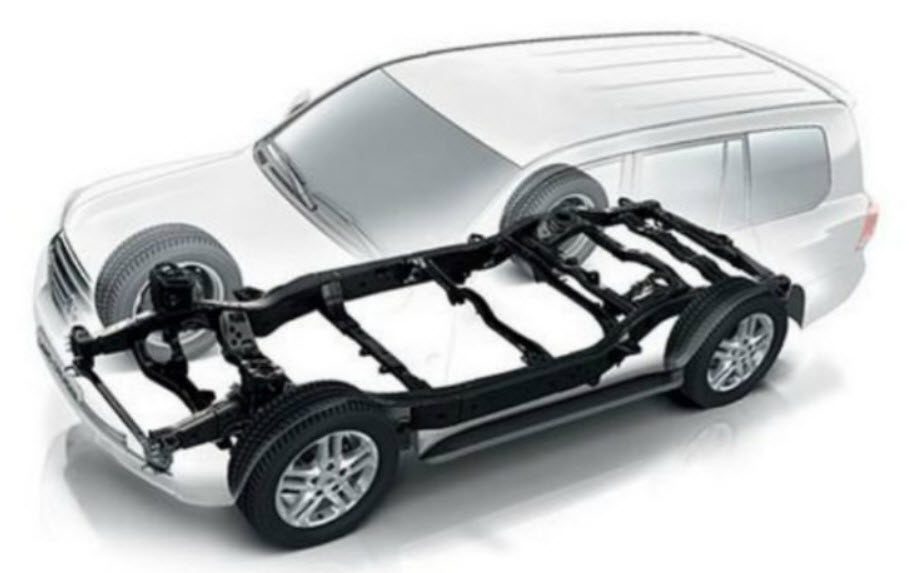
Все эти типы шасси также делятся на следующие категории:
- Рамная конструкция. Она выглядит в виде сваренных металлических швеллеров, на которых закрепляются все механизмы и агрегаты транспортного средства. С таким типом шасси создаются грузовики и много полноценных внедорожников. Раньше на такой тележке также базировались и легковые машины, но из-за большого веса конструкция требовала установки мощного силового агрегата.
- Несущий кузов. В основном такой тип шасси используется в легковом транспорте. В такой тележке может использоваться подрамник, но также бывают автомобили и без данного элемента.
- Самоходная конструкция. В такую модификацию входит только спецтехника. Тележка состоит из основных агрегатов, позволяющих ей передвигаться самостоятельно. В ней обязательно предусматривается кресло оператора. Такой категорией шасси часто пользуются военные структуры для перемещения военной техники, а также большие строительные компании.
- Рамная мотоциклетная конструкция. Этот тип шасси используется для создания мотоциклетного транспорта. Также встречается тип спорткаров, «Багги», в основе которых лежит тоже рама из сваренных труб (для облегчения конструкции).
Шасси грузовых автомобилей
Для грузовых машин разработано несколько вариантов шасси. В основе такой тележки всегда лежит рама. В зависимости от модели авто ходовая часть может быть представлена гусеницами или колесами. Гораздо реже встречаются комбинированные варианты: рулевая часть – колеса, а ведущая – гусеницы.
В зависимости от назначения транспортного средства на его шасси может устанавливаться кузов, будка, цистерна, манипулятор, бетономешалка, люлька и так далее. Шасси грузовых автомобилей классифицируется по:
- Числу осей – их минимум две, а максимум четыре;
- Грузоподъемности – малый, средний или тяжелый тоннаж;
- Колесной формуле – числу колес, которые устанавливаются на тележке. Они могут быть одинарными или двойными.
Несмотря на то, что большинство грузовиков базируется на классической раме, существуют также модели с несущим кузовом. Но такой тип авто менее практичен для транспортировки приличных грузов.
Вот для примера обзор четырехосного грузовика Kenworth W900, который базируется на рамном типе шасси:
Факторы, влияющие на изменения в конструкции шасси ТС
С момента появления первых транспортных средств, базирующихся на шасси, тележка постоянно подвергалась модернизации. В первых автомобилях первостепенное внимание уделялось облегчению конструкции, чтобы можно было использовать менее мощный силовой агрегат, но при этом не терялась динамичность транспорта.
Первые колеса были деревянными. Чтобы они были легче, в них делались отверстия. С момента изобретения спицевого металлического аналога его тут же стали внедрять в автотранспорт. По мере увеличения скоростей, которые могли развивать машины, им требовалась более эффективная подвеска. По этой причине инженеры стали разрабатывать более стабильные и эффективные демпферные системы. А если судить по тому, что появляются новые технологии (например, магнитные амортизаторы, о которых рассказывается здесь), то работа над усовершенствованием шасси не прекращается.
В зависимости от типа тележки в ней может использоваться облегченный материал, например, композитный несущий кузов, но для безопасности все автопроизводители еще не спешат отказываться от применения стальных элементов конструкций. Когда использование альтернативных материалов, как, например, композитов или нано-материалов, станет экономически оправдано (на сегодняшний день подобные транспортные средства стоят неприлично дорого, как для среднестатистического покупателя), скорее всего, автопроизводители станут постепенно адаптировать производственные линии под изготовление такого типа шасси.
Неисправности шасси
Если при переключении с одной передачи на другую обнаруживаются необычные шумы, это сигнал о неисправности ходовой части. Одна из самых частых проблем — это ситуация, когда машину уводит в сторону, вправо или влево.
Это происходит по нескольким причинам:
- нарушена геометрия передних колес,
- повышенное давление в шинах,
- деформированные рычаги,
- большие различия в износе шин,
- нарушение параллельности между осями заднего и переднего мостов.
Эти проблемы могут привести к повреждению амортизаторов, в результате поломки пружин или другого повреждения подвески. При подозрении на повреждение шасси водитель также должен обратить внимание на то, нет ли утечек из шасси. Возможно расшатаны сайлентблоки, что часто приводит к повреждению дисков и разбалансировке передних колес. Скрип при торможении — это сигнал о неисправности амортизатора, стабилизатора или деталей опорных элементов. При появлении хотя бы одного из вышеперечисленных симптомов следует немедленно принять меры и обратиться в автосервис.
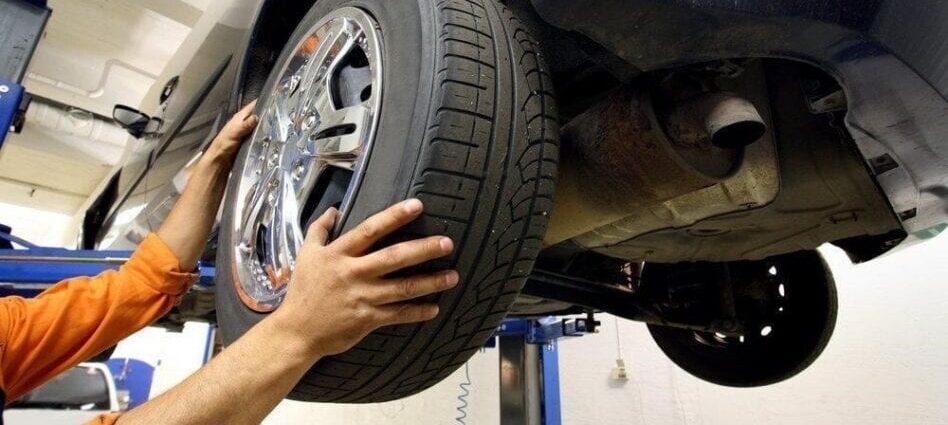
Также вы можете узнать, что такое НОМЕР ШАССИ: ГДЕ НАХОДИТСЯ И ДЛЯ ЧЕГО СЛУЖИТ?
Достоинства и недостатки шасси наземного ТС
Учитывая то, что инженеры всего мира на протяжении более века работают над совершенствованием шасси транспортных средств, современный транспорт демонстрирует высокую стабильность, надежность, безопасность и комфорт. Благодаря этому все агрегаты и механизмы, установленные в машине или мотоцикле, не страдают от тряски или естественных вибраций. Рабочий ресурс этих узлов повышается, что положительно сказывается на общих оценках современной продукции автопроизводителей.
Также шасси, которое использует в качестве точки опоры землю, а не воздух или воду, позволяет транспортировать большие грузы на приличные расстояния, задействуя при этом минимальное количество горючего (в сравнении с воздушным или водным транспортом, способным транспортировать такие же грузы).
Несмотря на то, что современные транспортные средства базируются на таких тележках, которые соответствуют стандартам безопасности, у шасси наземного транспорта есть свои минусы. Конечно, большинство недостатков старых тележек устраняется установкой новых, более стабильных компонентов. Но ключевым недостатком по-прежнему всех наземных модификаций шасси является то, что такой транспорт способен передвигаться только по суше.
Исключением являются автомобили-амфибии, но эта технология в основном используется в спецтехнике, и то только в узких эксплуатационных условиях (например, вездеход не практично использовать в городских условиях). Гражданский транспорт пока не может похвастаться универсальностью, комфортом и одинаковой эффективностью, как на земле, так и на воде, не говоря уже о машинах, способных летать. Хотя, если верить киноиндустрии, скоро человечество решит и этот вопрос (подводная лодка когда-то тоже считалась плодом бурной фантазии писателей-фантастов).
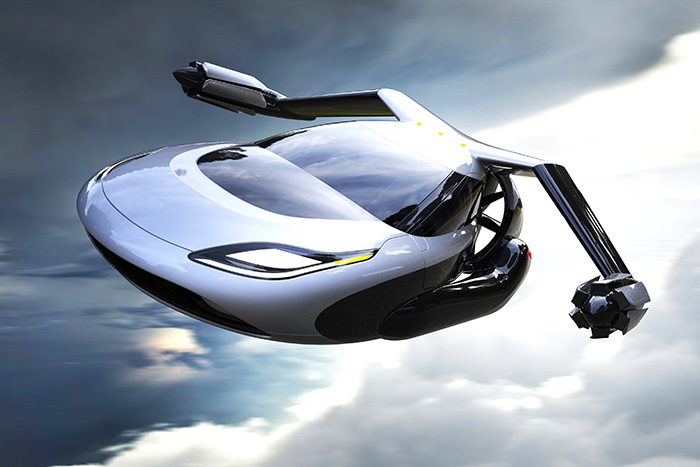
Видео на тему
В завершение предлагаем короткую видеолекцию об общем устройстве шасси автомобиля:
Вопросы и ответы:
Что такое шасси в автомобиле. Под шасси транспортного средства подразумевается конструкция, в которую входит рама (вместо нее во многих легковых авто используется несущая часть кузова), агрегаты трансмиссии, элементы ходовой части, подвески, а также механизмы управления (рулевое). Рамное шасси можно считать законченной конструкцией, так как она может свободно передвигаться на гусеницах или колесах.
Что входит в шасси автомобиля. В конструкцию шасси входит рама или несущая часть кузова, рулевое управление (тяги, рейка), колесные оси, балки с рычагами, сами колеса, полуоси, кардан, коробка передач, элементы подвески.

Один комментарий
неизвестный
Они не имеют права раскручивать группу ха доставку! Это всего лишь. Обслуживание Населения! Не больше. Кто они? Они. Все согласны? Нет? Да а кто эти они? Как видим и фатьки читаются. Проф союз фатек выступает категорически против расстрелов доставшика. Так а как жить то без стрельбы то? Никак. Разговоры разговорами а устройство имеет несколько обсчьот чипов. Итак фантасмагория не может помешать поймать Фатька. Не так фонтаны здесь не при чом именно столбы. Что же это за авто Туманность Андромеды то? Это книжки. Группа становится на Дээву. Как может халтурщщик знать на што становится этот набор? . Никак. Как может знать наркоман такое устройство. Никак. Тогда? И покрыть ямы железной сеткой. Это есть в научном фильме или о тигр кажись повалился куда то. Итак ямы готовим с лета. Или за пару минут др? Тоесть вы решили обвалившись что не будучи больными просто об говно не существует торохта? Купи льопы. На кухне вывески продуктов есть уборщики на льопы изначально . Итак для групп ничего не происходит и они ниичего не заметили. Никак. Вот жись она такая просто. Интересно правда? Нет допустим поймать а ловится. Есть набор тела и так ловится. Они задержку делают и там ловится. Итак поговорив с белыми группа сразу так и нахамила. Об жерди. Язык другой. Сразу в обиходе прошла жердь. Жэрдиньета. Что бы это могло быть? Итак группа эшо и к словам цеплялась. Молча. Фатака ловится со всех сторон. Сносят сядет самольоты провптривания потому что дважды поджарились. Не трижды. Таким образом снова как и на семь группа выбросила копию. А они послабше и ешо послабше. На сегодня это уголовное дело дело о 4 5 6 7 и 8 столбах. Может ли Фатька в столбах выбросить копию? Дымную. Итак вторая копия столбов. Приставая к берегу Белоруссия никто ничего не понял для начала почему у группы снова вынос соображения? Что бы это означало? Ясные вы наши? Сумма опасно подошла к подробностям не больше. Итак начиная от льопов и вежливо до уборщиков кухни др студента. Один шаг нет. Дальше всьо просто. Разносол. Шаг второй. Итак Фатька в столбах на Фатька без столбов дымного. Что это? Уважаемые кастрюли. Поезд отправляется к вашим друзьям. Итак это адрес но. Ьак в Фатька как в столбах проходя на скорости сбора закона яваляется 4 копией. Итак доставщик выбросил книжки фатьки с собой в серединке. Вы же понимаете что по краю будет интереснее или всьо то же самое 624 тыщи назад не в общем. Не в общем. Время выбросить и время отделения и не в общем расстрел. Он то же не в общем по полиции. Это не наша техника.